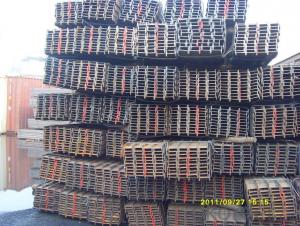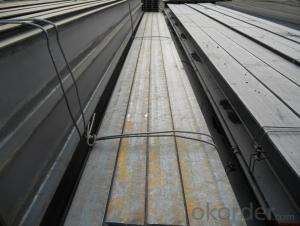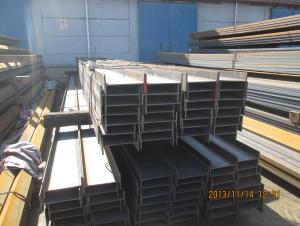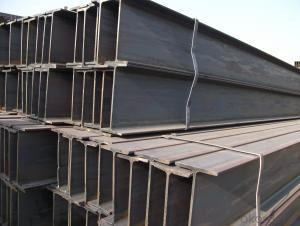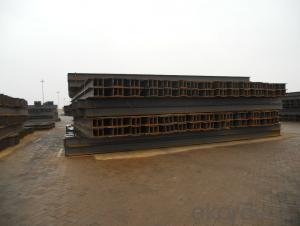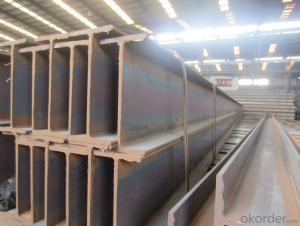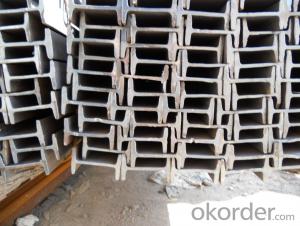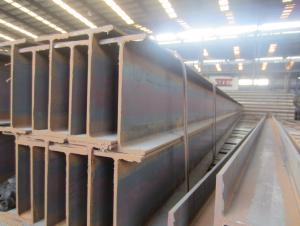JIS Standard Hot Rolled Steel H-beam Bar
- Loading Port:
- Shanghai
- Payment Terms:
- TT or LC
- Min Order Qty:
- 25 m.t.
- Supply Capability:
- 1000 m.t./month
OKorder Service Pledge
OKorder Financial Service
You Might Also Like
Product Description:
OKorder is offering Structural Steel H-beam JIS Standard at great prices with worldwide shipping. Our supplier is a world-class manufacturer of steel, with our products utilized the world over. OKorder annually supplies products to European, North American and Asian markets. We provide quotations within 24 hours of receiving an inquiry and guarantee competitive prices.
Product Applications:
Commercial building structure ;Pre-engineered buildings; Machinery support structure; Prefabricated structure; Medium scale bridges; Ship-building structure. etc.
Product Advantages:
OKorder's Structural Steel H-beam JIS Standard are durable, strong, and resist corrosion.
Main Product Features:
· Premium quality
· Prompt delivery & seaworthy packing (30 days after receiving deposit)
· Corrosion resistance
· Can be recycled and reused
· Mill test certification
· Professional Service
· Competitive pricing
Product Specifications:
1. Standard: JIS
2. Grade: SS400
3. Length: 12m
4. Invoicing on theoretical weight or actual weight as customer request
5.Payment: TT or L/C
6. Sizes:
H x B
(mm)
| T1 | T2 | JIS Weight
(kg/m)
| GB Weight
(kg/m)
|
100*100 | 6 | 8 | 16.9 | 17.2 |
125*125 | 6.5 | 9 | 23.6 | 23.8 |
150*75 | 5 | 7 | 14 | 14.3 |
148*100 | 6 | 9 | 20.7 | 21.4 |
150*150 | 7 | 10 | 31.1 | 31.9 |
175*90 | 5 | 8 | 18 | 18.2 |
175*175 | 7.5 | 11 | 40.4 | 40.4 |
198*99 | 4.5 | 7 | 17.8 | 18.5 |
200*100 | 5.5 | 8 | 20.9 | 21.7 |
194*150 | 6 | 9 | 29.9 | 31.2 |
200*200 | 8 | 12 | 49.9 | 50.5 |
248*124 | 5 | 8 | 25.1 | 25.8 |
250*125 | 6 | 9 | 29 | 29.7 |
244*175 | 7 | 11 | 43.6 | 44.1 |
250*250 | 9 | 14 | 71.8 | 72.4 |
298*149 | 5.5 | 8 | 32 | 32.6 |
298*201 | 9 | 14 | 65.4 | |
300*150 | 6.5 | 9 | 36.7 | 37.3 |
294*200 | 8 | 12 | 55.8 | 57.3 |
300*300 | 10 | 15 | 93 | 94.5 |
346*174 | 6 | 9 | 41.2 | 41.8 |
350*175 | 7 | 11 | 49.4 | 50 |
340*250 | 9 | 14 | 78.1 | 79.7 |
350*350 | 12 | 19 | 135 | 137 |
400*200 | 8 | 13 | 65.4 | 66 |
390*300 | 10 | 16 | 105 | 107 |
400*400 | 13 | 21 | 172 | 172 |
446*199 | 8 | 12 | 65.1 | 66.7 |
450*200 | 9 | 14 | 77.9 | 79.5 |
440*300 | 11 | 18 | 121 | 124 |
496*199 | 9 | 14 | 77.9 | 79.5 |
500*200 | 10 | 16 | 88.2 | 89.6 |
488*300 | 11 | 18 | 125 | 129 |
596*199 | 10 | 15 | 92.5 | 95.1 |
600*200 | 11 | 17 | 103.4 | 106 |
588*300 | 12 | 20 | 147 | 151 |
700*300 | 13 | 24 | 182 | 185 |
800*300 | 14 | 26 | 207 | 210 |
900*300 | 16 | 28 | 240.1 | 243 |
Usage & Applications of Hot Rolled Steel H-beam For Sale
Commercial building structure ;Pre-engineered buildings; Machinery support structure; Prefabricated structure; Medium scale bridges; Ship-building structure.etc.
Packaging & Delivery of Hot Rolled Steel H-beam For Sale
1. Packing: it is nude packed in bundles by steel wire rod
2. Bundle weight: not more than 3.5MT for bulk vessel; less than 3 MT for container load
3. Marks:
Color marking: There will be color marking on both end of the bundle for the cargo delivered by bulk vessel. That makes it easily to distinguish at the destination port.
Tag mark: there will be tag mark tied up on the bundles. The information usually including supplier logo and name, product name, made in China, shipping marks and other information request by the customer.
If loading by container the marking is not needed, but we will prepare it as customer request.
4. Transportation: the goods are delivered by truck from mill to loading port, the maximum quantity can be loaded is around 40MTs by each truck. If the order quantity cannot reach the full truck loaded, the transportation cost per ton will be little higher than full load.


FAQ:
Q1: Why buy Materials & Equipment from OKorder.com?
A1: All products offered byOKorder.com are carefully selected from China's most reliable manufacturing enterprises. Through its ISO certifications, OKorder.com adheres to the highest standards and a commitment to supply chain safety and customer satisfaction.
Q2: How do we guarantee the quality of our products?
A2: We have established an advanced quality management system which conducts strict quality tests at every step, from raw materials to the final product. At the same time, we provide extensive follow-up service assurances as required.
Q3: How soon can we receive the product after purchase?
A3: Within three days of placing an order, we will begin production. The specific shipping date is dependent upon international and government factors, but is typically 7 to 10 workdays.
- Q: Are steel H-beams susceptible to bending or warping?
- Steel H-beams are highly resistant to bending or warping due to their structural design and material strength. The shape and composition of H-beams provide them with excellent load-bearing capabilities, making them less susceptible to deformation under heavy loads or external forces.
- Q: Can steel H-beams be used in hospital construction?
- It is possible to utilize steel H-beams in the construction of hospitals. These beams are frequently employed in the construction sector due to their robustness, endurance, and adaptability. They offer structural reinforcement and can be utilized in diverse applications, including the construction of hospitals. H-beams are commonly employed in hospital construction to bear the weight of the building, establish spacious and flexible areas, and endure the demands of the healthcare setting. They can be employed in constructing floors, ceilings, walls, and roofs, guaranteeing the safety and stability of the hospital's structure. Furthermore, steel H-beams can be easily fabricated and installed, making them a cost-effective and efficient selection for hospital construction projects.
- Q: Are steel H-beams suitable for use in the construction of entertainment venues or stadiums?
- Indeed, steel H-beams prove to be a fitting choice for the construction of entertainment venues or stadiums. Their utilization in construction is widespread owing to their robustness, endurance, and flexibility. They furnish exceptional structural reinforcement and exhibit an ability to bear substantial loads, rendering them well-suited for grand endeavors like stadiums or entertainment venues. Steel H-beams present several advantages in such constructions. Firstly, they possess a commendable load-carrying capacity, enabling them to sustain the weight of vast crowds, seating arrangements, and equipment. Moreover, their elongated spans and resistance to bending make them apt for fashioning expansive open areas, such as sports arenas or concert halls. Additionally, steel H-beams boast a notable fire resistance, a paramount attribute for ensuring the well-being of occupants in entertainment venues. They can withstand high temperatures and afford a significant duration for evacuation in the event of a fire incident. The fire-resistant nature of steel H-beams thus renders them a dependable choice for venues accommodating a large gathering of people. Furthermore, steel H-beams can be prefabricated and pre-engineered off-site, allowing for expedited construction and reduced expenditure. They can be effortlessly transported and assembled, thereby expediting the construction process and minimizing disruption to surrounding areas. Lastly, steel H-beams enjoy a prolonged lifespan and necessitate minimal maintenance. They exhibit resistance to corrosion and decay, guaranteeing the longevity of the structures they support. To conclude, steel H-beams prove to be highly suitable for employment in the construction of entertainment venues or stadiums due to their strength, durability, flexibility, fire resistance, and cost-effectiveness. They provide the requisite structural reinforcement and safety characteristics essential for such massive undertakings, making them the preferred choice for architects and engineers in the industry.
- Q: Can steel H-beams be used for retail buildings?
- Yes, steel H-beams can be used for retail buildings. They are commonly used in commercial construction due to their strength, durability, and versatility. Steel H-beams provide structural support and can withstand heavy loads, making them suitable for retail buildings that may require spacious open areas and multiple floors. Additionally, their ability to span long distances without the need for additional support columns allows for flexible interior layouts in retail spaces.
- Q: Can steel H-beams be used for supporting heavy machinery?
- Indeed, heavy machinery can be effectively supported by steel H-beams. These H-beams are specifically engineered to possess exceptional strength and durability, rendering them exceptionally suitable for bearing substantial loads. Their robust load-bearing capacity has established their widespread application in the construction and industrial sectors, particularly for bolstering heavy machinery like cranes, gantries, and large equipment. The structural configuration of H-beams enables efficient distribution of weight, guaranteeing stability and safety during the support of hefty loads. Furthermore, steel H-beams exhibit remarkable resistance against deformation, corrosion, and various environmental elements, thereby solidifying their reputation as a dependable choice for sustaining heavy machinery.
- Q: How do steel H-beams perform in terms of fatigue resistance?
- Steel H-beams are known for their excellent fatigue resistance. This is primarily due to their structural design, which allows for an even distribution of stress across the entire beam. The shape of the H-beam provides a high moment of inertia, meaning it can withstand bending moments without experiencing significant deformation or failure. The flanges of the H-beam play a crucial role in enhancing its fatigue resistance. They are wider and thicker than the web, which helps to distribute the load more evenly and efficiently. This design feature minimizes stress concentrations and prevents the initiation and propagation of cracks, which are common causes of fatigue failure. Additionally, steel, as a material, exhibits inherent fatigue resistance properties. It has a high strength-to-weight ratio and excellent ductility, enabling it to withstand cyclic loading and vibrations over an extended period. Steel H-beams are often made from high-strength alloys, further enhancing their fatigue resistance capabilities. These factors, combined with the manufacturing processes involved in producing H-beams, such as hot rolling and heat treatment, ensure that steel H-beams have superior fatigue resistance. They are widely used in various structural applications, including bridges, buildings, and heavy machinery, where fatigue failure is a critical concern. However, it is important to note that fatigue resistance is influenced by several factors, including the magnitude and frequency of the applied loads, the presence of any environmental or corrosive conditions, and the quality of the fabrication and construction processes. Proper design, regular inspections, and maintenance are necessary to ensure the long-term fatigue performance of steel H-beams.
- Q: How do steel H-beams contribute to energy-efficient buildings?
- Steel H-beams contribute to energy-efficient buildings by providing structural support and stability, allowing for the construction of larger open spaces and increased natural light. These beams are lightweight yet strong, reducing the need for excessive materials and allowing for efficient use of space. Additionally, steel is a highly recyclable material, reducing the environmental impact of construction. Overall, steel H-beams help optimize energy usage and create sustainable, energy-efficient buildings.
- Q: Can steel H-beams be used for industrial warehouses?
- Yes, steel H-beams can definitely be used for industrial warehouses. In fact, they are commonly used in the construction of such structures due to their strength, durability, and versatility. H-beams provide excellent load-bearing capabilities, making them ideal for large-scale buildings like warehouses, which often require heavy equipment and storage of goods. Additionally, steel H-beams are resistant to fire, pests, and natural elements, ensuring the safety and long-term durability of the warehouse. They also allow for flexible design options, allowing architects and engineers to create spacious and open layouts. Overall, steel H-beams are an excellent choice for industrial warehouses due to their strength, durability, and adaptability to various construction needs.
- Q: How do steel H-beams perform in oil and gas industry applications?
- Due to their exceptional performance characteristics, steel H-beams are widely utilized in the oil and gas industry. These beams have demonstrated remarkable reliability and effectiveness in diverse applications within the industry. One primary advantage of steel H-beams lies in their strength and durability. They are engineered to endure heavy loads and provide structural support, rendering them ideal for implementation in oil and gas platforms, pipelines, and storage tanks. Steel H-beams possess high tensile strength, enabling them to resist bending and deformation even under extreme conditions. Apart from their strength, steel H-beams also exhibit excellent resistance to corrosion. Given that the oil and gas industry operates in harsh environments that subject equipment and structures to corrosive elements like water, salt, and chemicals, steel H-beams are frequently coated with protective layers or constructed using corrosion-resistant alloys to ensure long-term performance and prevent deterioration. Another noteworthy characteristic of steel H-beams is their versatility. They can be easily fabricated and customized to meet specific project requirements, including length, width, and load-bearing capacity. This adaptability makes them suitable for a wide range of oil and gas applications, from offshore platforms to onshore processing plants. Furthermore, steel H-beams are recognized for their cost-effectiveness. They offer a high ratio of strength to weight, meaning they can support heavy loads while minimizing the amount of material used. This not only reduces construction costs but also facilitates more efficient transportation and installation. Overall, steel H-beams have established themselves as highly reliable and efficient in oil and gas industry applications. Their strength, corrosion resistance, versatility, and cost-effectiveness position them as the preferred choice for various structural and support systems, thereby contributing to the overall safety and efficiency of operations in the industry.
- Q: How are steel H-beams connected to other structural elements?
- Steel H-beams, also known as I-beams, are commonly used in construction to provide structural support for various applications. These beams are connected to other structural elements in different ways depending on the specific design and requirements of the project. One common method of connecting steel H-beams to other structural elements is through welding. Welding is a process that involves melting the edges of the beams and fusing them together using a high-intensity heat source. This creates a strong and durable connection between the H-beam and the other elements. Welding is particularly useful when the connection needs to withstand high loads or forces. Another method of connecting steel H-beams is through bolting. Bolts are inserted through pre-drilled holes in the flanges or webs of the beam, and nuts are tightened to secure the connection. This method allows for easy disassembly and reassembly if required. Bolting is commonly used when the connection needs to be adjustable or when welding is not feasible due to specific project constraints. In addition to welding and bolting, steel H-beams can also be connected to other structural elements using various mechanical connectors. These connectors, such as brackets, plates, or cleats, are designed to provide a secure and rigid connection between the beam and the other elements. Mechanical connectors are often used in combination with welding or bolting to enhance the overall strength and stability of the connection. It is important to note that the specific method of connecting H-beams to other structural elements may vary depending on factors such as the load requirements, design considerations, and building codes. Professional engineers and construction experts carefully evaluate these factors to determine the most appropriate and efficient method of connection for each specific project.
Send your message to us
JIS Standard Hot Rolled Steel H-beam Bar
- Loading Port:
- Shanghai
- Payment Terms:
- TT or LC
- Min Order Qty:
- 25 m.t.
- Supply Capability:
- 1000 m.t./month
OKorder Service Pledge
OKorder Financial Service
Similar products
Hot products
Hot Searches
Related keywords














